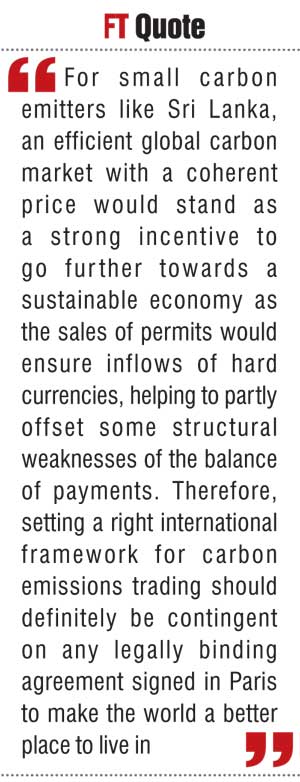Sunday Dec 14, 2025
Sunday Dec 14, 2025
Wednesday, 14 October 2015 00:00 - - {{hitsCtrl.values.hits}}

At first sight, a green finance could be interpreted as contradictory, as for many finance goes hand in hand with excessive greed, economies in dire straits and little interest in environmental considerations. Yet this growing brand of finance basically encompasses all financial instruments fostering the transition towards a low-carbon economy
This year the combat against climate change is at the top of the international agenda as the 21st Conference of the Parties to the UNFCC (COP21) will take place in Paris under French presidency.
During the first 10 days of December around 40, 000 official delegates from 195 countries will meet in the French capital to negotiate a legally binding agreement to stabilise the climate. A successful agreement should curb, over the long-term, average global surface warming at a maximum of 2 °C, compared to the pre-industrial level. Along this ultimate objective, the financing of greenhouse gas mitigation and adaptation to climate change, the so-called “green finance”, will be part of the discussions. 
At first sight, a green finance could be interpreted as contradictory, as for many finance goes hand in hand with excessive greed, economies in dire straits and little interest in environmental considerations. Yet this growing brand of finance basically encompasses all financial instruments fostering the transition towards a low-carbon economy.
As we will see, every finance stakeholder, from governments to private investors, has actually a high potential of transformative impact to take-up the challenge of fighting global climate change.
A world economy starving for green infrastructure
Putting aside the recent slowdown of economic growth in China and the expected US Federal Reserve’s interest rate hike, the world economy stands at a critical juncture.
First, the world is starving for investments in infrastructure. Obsolete infrastructure in developed countries and lack of suitable ones in developing countries, enabling them to accommodate structural changes, are reckoned to be costly in terms of growth. Those investments play indeed a key role in increasing the potential economic growth by spurring productivity gains among other things. They include energy production and distribution, water-supply, transport, airports and every tangible assets easing the access to markets for consumers and producers.
Meanwhile, as pointed out by the Fifth Assessment Report1 of the Intergovernmental Panel on Climate Change, “human influence on the climate system is clear, and recent anthropogenic emissions of greenhouse gases are the highest in history” with “widespread impacts on human and natural systems”. Importantly, the IPCC warns that a rise of average global surface temperature superior to 2°C will be detrimental to any hopes of a fairer global economic development due to the harsher effects of climate change on developing countries.
According to IPCC, reaching carbon neutrality by 2100 is a sine qua non condition to stabilise the global warming at the 2°C trigger. We must emphasise that this neutrality does not imply zero carbon emissions rather making the natural absorption of all the carbon released because of human activities possible. Before the industrial revolution, natural carbon sinks, such as oceans, forests, soils and vegetation, have actually contributed to a next to carbon neutral world. As a consequence, every member of the international community should now factor in carbon-neutrality, adaptation and resilience in its decisions of new investment into infrastructure.
Public finance has definitely to pave the road
As evidenced by many surveys conducted by IMF or top consultancies, the world needs to mobilise billions of dollars every single year to fund the urgently needed green infrastructure. Unquestionably, part of these funds have to come from the public sector as it has to chart the way ahead. This is why, along the negotiations on the legally binding agreement, the countries’ official delegates are expected to find a way to jointly commit $ 100 billion dollars a year by 2020 to combat climate change.
The Green Climate Fund (GCF), established in 2009 in Copenhagen along the COP15, is to be the main channel for a public green finance. This fund has been designed to promote a “paradigm shift” in the global economic development by financially supporting countries in their efforts to mitigate greenhouse emissions and their need for adaptation to climate change.
The contributions consist of grants, capital and loans sourced from developed and developing countries. Provided with these funds, the GCF will target game-changer investments that have a huge impact on greenhouse emissions reduction and are likely to catalyse further investments by reducing entry costs and creating new investment opportunities.
In this regard, the GCF will provide mainly developing countries with financing in the form of grants and subsidised lending. The access to funds will be available for international and national entities accredited by the GCF’s Board.
In Sri Lanka, the Sri-Lankan Carbon Fund is likely to be the recipient of these funds. Besides the investment dimension, the fund will financially accompany willing countries in the design of their national policies and sectorial strategies intended to cope with the climate issue.

Public money could be too short
So far, both developed and developing countries had only pledged funds amounting to $ 10 b. This is obviously nowhere near to the ambitious target of $ 100 b a year. In fact, too many governments across the world are cash-strapped because of large fiscal deficit and huge piles of debt to be paid off. The latter reaches on average 100 % of GDP in the OECD, a group of mostly rich countries.
Public finances in tatters could impair the ability of states to easily honour such a promise. Though, a gradual end to the inefficient and socially costly fossil energy subventions in too many countries would clearly give leeway to switch money into green infrastructures.
In a recent compelling study2, IMF researchers found out that these subventions cost $ 5, 300 b worldwide and a significant sum of $ 2.6 b in Sri Lanka, almost half of the current public investment in the country. But even if public money has a leading role to finance the transition towards a carbon neutral economy it cannot be the only answer.
No more banking as usual
In a world of still prominent banking intermediation, banks should adapt their business model to the climate change by reorienting their funding towards low-carbon projects or stopping the financing of polluting projects.
Lately, Crédit-Agricole, a global French bank, committed to curb financing new coal thermal powers in the high income countries. Some other big US and UK global banks are already under scrutiny by environmentally minded shareholders who want to see them disclosing more about their lending to firms that contribute to greenhouse gas emissions. Last year, at least four of these leading banks have seen their shareholders filing nonbinding resolution to commit them to such disclosures.
Moreover, they are also pushing the banks to take measures aiming at addressing climate change. Though, banks could have reduced margin of actions to finance the economic transition as they have to maintain high regulatory capital ratio under Basel III regulation framework. At the country level, central bankers could at some point get involved fight climate change which is likely to cause big losses for banks and insurers and in fine for investors.
Mark Carney, the highly respected Governor of the Bank of England, has recently raised the alarms by declaring that “in the fullness of time, climate change will threaten financial resilience and longer-term prosperity”. Central banks could then act to “green» their banking system and prepare investors to the transition towards a low-carbon economy before the irreversibility of this “Tragedy of the Horizon”3.
That is why the Bangladesh Bank, at the vanguard of green central banking, announced, last March, $ 500 million of cheap funds to make the- key but polluting- textile sector cleaner. Additionally, the same monetary authority requested banks to allocate 5% of their loans into green projects by 2016.
Let’s tap the financial markets as well
Yet, on the global financial markets lies a still untapped source of financing. Let’s just think of the great amount of cash held by institutional investors. Pension funds, insurers, mutual funds, etc., are holding an estimated $ 100 trillion in assets under management. It is twice the total OECD’s GDP. At the global scale, the accumulation of savings is unprecedented and mark a shift towards global banking disintermediation.
Due to their stable and long-term liabilities, these investors could be a productive source of funding for illiquid but not volatile assets such as green infrastructure. Moreover, their growing size and presence on global financial markets can make them key players for “greening” the economy. Indeed, by divesting from polluting firms, according to environmental screening, green investors, in critical proportion, can incentivise the firms conducting polluting projects to reform themselves by increasing their weighted average cost of capital4.
But at the moment, investment in infrastructure by these investors is tiny and represents less than 1% of the total assets managed. It means there is something definitely wrong in terms of incentives. Basically, two major impediments are blocking the road towards a greater money allocation into infrastructure.
First, there is clearly a regulatory risk encompassing time-inconsistency in policies, lack of good governance and transparency in many countries to take risks on such illiquid assets. Second, there is a lack of available assets matching the risk-return expectations of these investors. Hence, improved public policies should be followed to attract these investors into low-carbon infrastructure as they have clearly a strong appetite for green returns.
Even Mr. Bond is going green
As a piece of evidence, one has to take a look at the expanding green bond market. Last year, total issuance reached record $ 35 b against $ 11 b in 2013. This plain debt instrument, first issued by the International Finance Corporation, the private sector arm of the World Bank, in 2007, has been fully dedicated, since market’s inception, to financing low-carbon projects such as large-scale renewable energy projects in Mexico and the extension of clean urban transport in Colombia.
Green bonds actually share every characteristic of standard bonds. However, they have to meet high environmental standards related to the projects they finance and must be subject to close monitoring by independent accredited agencies to be labelled as such.
Interestingly, as the market grows, the issuers and the financial instruments are getting more diversified. Indeed, a rising number of private firms are using these debt instruments to raise money as they allow them to reach a broader base of investors who are increasingly environmentally minded. Last year, ENGIE (ex-GDF Suez), a French utility, successfully issued the largest green bond ever, with $ 2.8 b intended to finance green projects over 12 years.
Recently, the World Bank and BNP Paribas, a leading French bank, have jointly engineered the first equity-linked green note. It is actually a structured financial product based on the evolution of the Ethical Europe Equity Index, a dynamic basket of shares issued by environment-friendly firms.
In a global context of low interest rates, this financial product allows green investors to capture higher – but green – returns than investing in bonds. These ongoing innovations, though they are still in their infancy, are full of promises as they contribute to expand the span of available assets, enabling investors to achieve more risk-return profiles as well as voting with their money for a greener future.
The carbon market as a solution to fault-lines of capitalism
Against a widespread belief financial markets have more than ever to play a role to finance the transition towards a carbon neutral economy. Along with providing green financing, market forces must also make polluters go green by making them pay the price of their carbon emissions. These negative externalities are costs borne by the whole society which outweigh the fraction of collective profits generated by polluting activities.
As pointed out by Jean Tirole5, a French Nobel Prize in Economic Sciences rewarded last year, one efficient way of dealing with is to establish a well-functioning worldwide carbon market with a unique price across all countries.
At the moment, more than a dozen fragmented carbon markets exist but the wide differences in carbon prices make their impact tiny at a large scale. A global and unique price driven by the market forces should then be allowed. Price consistency should be set by allocating fair allowances entitling each country to a specific level of emissions without sectoral differentiation.
Such a system would permit carbon savers to sell their surplus of allowances to countries who need more than their initial endowments. Here, is one of the essential roles of financial markets. Yet compliance with such a trading scheme has to be ensured by enforcing credible penalties against countries who violate the rules of the game.
For instance, a shortfall of permits at the end of the year could add to the stock of national debt converted at the current market price and put under supervision of a multilateral body like the International Monetary Fund or the Bank for International Settlements. Besides, for small carbon emitters like Sri Lanka, an efficient global carbon market with a coherent price would stand as a strong incentive to go further towards a sustainable economy as the sales of permits would ensure inflows of hard currencies, helping to partly offset some structural weaknesses of the balance of payments.
Therefore, setting a right international framework for carbon emissions trading should definitely be contingent on any legally binding agreement signed in Paris to make the world a better place to live in.
(The writer is the Deputy Economic Counsellor at the Embassy of France in Sri Lanka and the Maldives. He holds a Master of Science in Finance from Paris-Dauphine, a leading French university in finance and economics.)
Footnotes
1 The synthesis report can be found at http://www.ipcc.ch/pdf/assessment report/ar5/syr/AR5_SYR_FINAL_SPM.pdf
2 The study and country estimates can be found at http://www.imf.org/external/np/fad/subsidies/index.htm
3 The full speech of Mark Carney can be found at http://www.bankofengland.co.uk/publications/Documents/speeches/2015/speech844.pdf
4 Robert Heinkel, Alan Kraus, Josef Zechner, The effect of Green Investment on Corporate Behavior, Journal of Financial and Quantitative Analysis, 2001
5 Jean Tirole, Some Political Economy of Global Warming, Economic of Energy and Environmental Policy, 2012